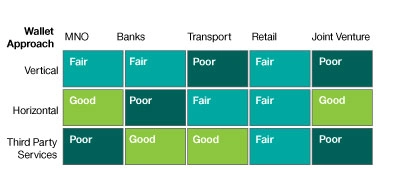How to develop a mobile wallet strategy: The business view
As I conclude my series on mobile wallets, I want to talk about the business view and offer some recommendations on how to develop a mobile wallet strategy.
Horizontal versus vertical integration
The main business dimension that you should consider when determining a mobile wallet business model is the differentiation between horizontal and vertical wallets.
In the case of horizontal wallets, the provider of a wallet integrates services from third-party suppliers.
With vertical wallets, the wallet provider is the service supplier itself and integrates only its own services within the wallet.
It is also possible for mobile wallet services, such as mobile ticketing, that are running within an autonomous wallet to be decoupled and integrated within other wallets. That is how transport companies can launch their own wallet for mobile ticketing and also allow their customers to save their mobile tickets within the wallets of third-party suppliers.
Integrating services into a mobile wallet
In general, wallets have a platform character, by which I mean that their value proposition includes the integration of various services into a single application. Ideally, the whole content of a physical wallet can be reproduced within a mobile wallet. That is why customers will likely use only a few wallets, or optimally just a single wallet that offers a broad range of advantageous features and services. The chances of success rise significantly for wallet providers that hold a neutral or monopolistic position within the market or an industry, and allow the integration of services from competing service providers like banks into their wallet.
For example, it would be quite difficult for a bank to establish a horizontal proximity wallet for credit card emulation. Banks are not neutral in this industry, and other banks will be reluctant to integrate their services into the wallet of a competitor. Telecommunication, transportation, logistics or technology companies that act as neutral players within the financial sector have considerably better chances of integrating various payment cards from different banks into their wallet.
A third option: Provide third-party services instead of a wallet
The subsequent figure shows an evaluation of the business potential of different mobile wallet approaches for stakeholders in key industries. Besides the vertical and horizontal approach, for those providing wallet services, like banks and transport companies, a third viable approach is to provide their services only to other wallet providers and not offer their own wallet (third-party services). Furthermore, joint ventures can be built among the stakeholders to provide a neutral wallet in an ecosystem. Such an approach has been followed in China by the major banks and mobile network operators (MNOs), or in the United States by the three major MNOs (Softcard).

The future market development of wallets and their chances of success cannot be seriously forecasted. Many providers are surging into the market with different kinds of mobile wallet solutions. Probably just a few will achieve the critical mass to endure over the long term. Those most likely to persist will have a clear strategic roadmap and objectives, as well as the flexibility to react to instant market and ecosystem changes, which might happen in this new and immature market at any time.
Recommendation on a mobile wallet strategy
To ensure a fast and successful market entry, I recommend that companies develop a goal-oriented and clearly defined mobile wallet strategy. How do you build such a strategy?
To begin with, you need to select and evaluate strategic opportunities and their resulting effects on your business model. Business partnerships and secure element integration must also be evaluated in terms of how they fit the strategic goals. And all of this should be built upon market impact analysis.
You should define your goals precisely as soon as you start to develop an enterprise mobile wallet strategy. Have a flexible action plan and roadmap for your strategy. Do a detailed analysis of the market and potential partners, conduct comprehensive feasibility studies and evaluate your opportunities and risks.









